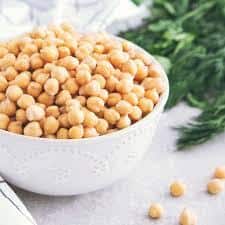Chickpeas are a kind of legume in the same family as kidney beans and peanuts. They’re also called garbanzo beans. They have a buttery, nutty flavor and creamy texture. In the U.S., we often see the Kabuli variety, which is tan, round, and slightly larger than a pea. In the Middle East and India, the Desi variety is more common. These are smaller, darker, and less round than Kabuli chickpeas.
Chickpea Nutrition Facts
The following nutrition information is provided by the USDA for 1 cup (152g) of canned chickpeas that have been drained and rinsed.1
- Calories: 210
- Fat: 3.8g
- Sodium: 322mg
- Carbohydrates: 35g
- Fiber: 9.6g
- Sugars: 6g
- Protein: 10.7g
Nutritional Importance Of Chickpeas
Chickpeas, also known as garbanzo beans, are a popular legume that is consumed around the world. They are known for their versatility in the kitchen and their nutritional value, making them a valuable addition to a healthy diet. In this blog, we will explore the nutritional importance of chickpeas and how they can contribute to overall health.
One of the key nutrients in chickpeas is protein. Chickpeas are a good source of plant-based protein, with one cup providing approximately 15 grams. Protein is important for the growth and repair of tissues, the production of enzymes and hormones, and the maintenance of muscle mass. Chickpeas also contain a range of amino acids, which are the building blocks of protein.
In addition to protein, chickpeas are also a good source of other nutrients. They are high in dietary fiber, with one cup providing approximately 12 grams. This makes them a good choice for maintaining healthy digestion and supporting weight management. Chickpeas are also a good source of several essential minerals, including iron, zinc, and phosphorus.
Chickpeas are also a good source of complex carbohydrates, which provide sustained energy and support blood sugar control. They are low in fat and have a low glycemic index, making them a good choice for people looking to maintain a healthy weight and blood sugar levels.
While chickpeas can be a nutritious addition to a balanced diet, it is important to remember that they should be consumed as part of a varied diet that includes a variety of nutrient-dense foods. It is also important to speak with a healthcare provider before adding chickpeas or any other supplement to your diet, as they may interact with certain medications or have potential side effects.
In conclusion, chickpeas are a nutritious legume that is high in protein, dietary fiber, and other essential nutrients. They are a good source of complex carbohydrates and can support healthy digestion and weight management. When consumed as part of a balanced and varied diet, chickpeas can contribute to overall health.
Glycemic Index Of Chickpeas
Chickpeas, also known as garbanzo beans, are a popular legume that is consumed around the world. They are known for their versatility in the kitchen and their potential health benefits, including their impact on blood sugar control. In this blog, we will explore the glycemic index of chickpeas and what this means for their potential impact on blood sugar.
First, it’s important to understand what the glycemic index is and how it is determined. The glycemic index is a ranking of foods based on how quickly they raise blood sugar levels. Foods with a high GI are rapidly absorbed and cause a rapid and large increase in blood sugar, while those with a low GI are absorbed more slowly and cause a slower and smaller increase in blood sugar. The GI is measured on a scale from 0 to 100, with higher values indicating a faster and larger increase in blood sugar.
So, what is the glycemic index of chickpeas? According to the International Tables of Glycemic Index and Glycemic Load, chickpeas have a GI of approximately 28. This is considered a low GI, which means that chickpeas are absorbed slowly and cause a slower and smaller increase in blood sugar. In comparison, foods with a GI of 70 or higher are considered high, and those with a GI of 56 to 69 are considered medium.
It’s important to note that the glycemic index of a food is only one factor to consider when it comes to its potential impact on blood sugar control. Other factors, such as the number of carbohydrates in a serving of the food and how it is prepared, can also affect blood sugar levels. Additionally, the glycemic index may not always accurately reflect the impact of food on blood sugar in an individual, as factors such as the individual’s age, weight, and activity level can also affect blood sugar response.
Overall, chickpeas have a low glycemic index and may be a good choice for people looking to maintain healthy blood sugar levels. However, it’s important to consider the glycemic index in the context of a balanced and varied diet, rather than relying on it as the sole factor in choosing foods. As with any food, it’s also important to eat chickpeas in moderation and to speak with a healthcare provider if you have any concerns about their potential impact on your health.
Health Benefits of Chickpeas
1)Promotes Heart health-
Chickpeas are high in fiber, containing 16% of your daily needs in one half-cup serving. About one-third of the fiber in chickpeas is soluble fiber, making it a heart-healthy food. Studies have shown that people who eat fiber-rich diets typically have a reduced risk of heart disease.
2) May Help Prevent Some Cancers
Several of the nutrients and compounds in chickpeas may protect against certain kinds of cancer.
- Fiber: Protective against colorectal cancer3
- Butyrate: Protective against colorectal cancer4
- Saponins: Protective against multiple types of cancer5
- B vitamins: Protective against breast and lung cancer
3)Regulates blood sugar level-
Chickpeas, like other legumes, contain resistant starch that slows down the digestion of carbohydrates. Some resistant starch is not digested in the small intestine at all. At least one study has shown that replacing more rapidly digested carbohydrates with legumes enhances glycemic control by improving insulin sensitivity in people with diabetes.
4) Helps in managing weight-
Foods that are high in fiber and protein can help you feel full and consume fewer calories overall. Research comparing chickpeas with white bread found that study subjects who consumed chickpeas had better glycemic control and suppressed appetite and calorie intake.9
A review of research found that including pulses (certain legumes, including chickpeas) in a diet leads to a weight loss effect even when diets are not designed to restrict calories.
5)Helps with digestion-
Chickpeas are high in dietary fiber, especially a soluble fiber called raffinose. The good bacteria in your gut breaks this down so your colon can digest it slowly. Studies have found that eating more chickpeas can help make bowel movements easier and more regular.
6)Helps lowering cholesterol-
Soluble fiber is good for more than gut health. It can lessen your total cholesterol and your LDL (“bad”) cholesterol. This lowers your risk of heart disease. Studies have shown that you can lessen your total cholesterol if you add chickpeas to your diet.
7)They give you stronger bones- Chickpeas and other legumes have calcium, magnesium, fiber, and other nutrients for strong bones. But be sure to soak them first to get rid of things called phytates, which can get in the way of your body absorbing the calcium in chickpeas.
8) They could boost your mental health-
Chickpeas have choline, a nutrient that helps make important chemicals for memory, mood, muscle control, and other brain and nervous system activity.
Allergies
Chickpeas are legumes, as are soybeans and peanuts (both of which are top allergens). Chickpea allergy is usually seen as a cross-reaction in people who already have a demonstrated allergy to soy, peas, lentils, or hazelnuts. If you have allergies to any of these foods, especially pea or lentil, or you experience any symptoms after consuming chickpeas, discuss your diet with your doctor to determine what is safe for you.11
Adverse Effects
Like other beans and high-fiber foods, chickpeas may cause some intestinal symptoms, like gas. Adding fiber to your diet gradually can help prevent these symptoms.
How to Prepare and Eat Chickpeas
You can buy them dried in a bag like beans and then soak them in water and boil them. Or you can buy them canned. Either way, they’re delicious and nutritious.
- Hummus. Chickpeas are the main ingredient in hummus, a delicious dip that also calls for tahini, lemon juice, and garlic.
- Soups and salads. Toss whole chickpeas onto any salad, soup, or stew.
- As a snack. Spread a layer of chickpeas on a baking sheet. Add your favorite seasonings and roast them until they’re golden and crunchy.
- Vegan cooking. Vegans love aquafaba, the liquid from canned chickpeas. It has similar properties to egg whites, and you can use it as an egg substitute.
Chickpeas are very healthy food.
They are high in vitamins, minerals, fiber, and protein. These characteristics are responsible for most of their health benefits, which range from weight management to blood sugar control.
Including chickpeas in your diet regularly will support your health and may reduce your risk of developing chronic diseases, such as heart disease and cancer.
They’re affordable and easy to find at most grocery stores. You can include them in various dishes, and they make an excellent meat alternative in vegetarian and vegan meals.
Furthermore, chickpeas are delicious and certainly worth including in your diet if you want to reap their health benefits.
Get yourselfstarted today and Stay tuned for more such keto weight lossjourneys, health content, andrecipes! Also, don’t forget to follow us onInstagram for the daily dose of the Keto Lifestyle.









